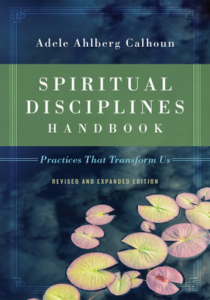Spiritual Disciplines Handbook: Practices That Transform Us (Revised and Expanded Edition)
Reviewed by Bob Dixon-Kolar
February 1, 2017
 By Adele Ahlberg Calhoun. InterVarsity Press, 2015. 352 pages. $22/paperback; $16.99/eBook.
By Adele Ahlberg Calhoun. InterVarsity Press, 2015. 352 pages. $22/paperback; $16.99/eBook.
The back cover of Adele Ahlberg Calhoun’s book, Spiritual Disciplines Handbook: Practices That Transform Us, asks potential readers, “Do you desire more of God?” The many and varied spiritual disciplines contained in this collection are all directed toward transforming our deepest yearnings into worship of the Divine. “I believe the root of all desire stems from our innate need to open our hearts to God,” says Calhoun. The author employs the word worship as an acronym for classifying the spiritual disciplines covered in the book’s seven parts:
- Worship God
- Open myself to God
- Relinquish the false self and idols of my heart
- Share my life with others
- Hear the word of God
- Incarnate Christ’s love for the world
- Pray to God
Calhoun is co-minister, with her husband, of Redeemer Community Church in Needham, Mass., an interdenominational congregation that describes itself as evangelical and orthodox, holding “to the centrality of Jesus Christ as our only Lord and Savior.” Through long study and her own soulful searching, Pastor Calhoun has written a compendium of 75 Christian devotional practices that can lead worshipers into the mystery of the Trinity.
These spiritual disciplines are imbued with the presence of the Triune God. The Father regards His creation with perfect love and acceptance; His grace has given the world the gift of his son Jesus, whose own healing love teaches us how to love. Jesus Christ is Master of our lives yet also our boon companion. And within our hearts, the Holy Spirit seeks us out, quickens our conscience, prompts us toward devotion, enlightens us in truth.
In a meditation on the manifold names of God, Calhoun offers this invitation:
Prepare to be in the presence of God. Imagine yourself coming to one of the persons of the Trinity: Father, Son or Holy Spirit. . . . Are you laying your head on the father’s shoulder? Are you sensing the wind of the Spirit that blows where it wills? Stay with God. Be open to listen. Allow God’s name to draw you in to the company of the holy Three in One.
Calhoun does not intend for her handbook to be read cover to cover. Readers are encouraged to select the spiritual disciplines that speak to their “longings or hungers or desperations.” One discipline that spoke to a desire in me is the “Labyrinth Prayer.” Calhoun sees walking a labyrinth as a kind of pilgrimage in the form of a “symbolic prayer walk . . . a journey toward God.” She notes that labyrinths (such as the famous labyrinth in the Chartres Cathedral) came into being “as a substitute for making a pilgrimage to a holy site.”
Inspired by Calhoun’s book, I recently went on two labyrinth walks. On my first walk, I was especially aware of the labyrinth as a symbol: how it imparts a sense of wholeness no matter how circuitous the path; how the “pilgrim” is always advancing toward the center even when the path, for a time, sends one away from it; how the journey inward always implies a return, renewed, to the world.
On my second labyrinth walk, a week later, I minded more, reflected less. I attempted to concentrate my attention on my breathing or on my footfall, resisting conceptualization and judgment. As I walked, a spontaneous mantra formed in my mind. Breathing in: “Love rises.” Breathing out: “Love circulates.”
Each of the spiritual disciplines in the handbook is described with a brief, thoughtful essay reflecting on the desires that the practice can fulfill and tracing its lineage within the Christian tradition.
Befitting the book’s designation as a “handbook,” every discipline is explained by means of a table divided into five sections: the desire motivating the discipline; a definition of the discipline; scripture verses that serve as the spiritual authority for the discipline; the practices entailed by the discipline; and the God-given fruits that issue from the discipline. The tables are, indeed, a handy way to review and compare spiritual practices.
Friends who are part of a spiritual formation group would find this book extremely helpful. For each discipline, Calhoun offers reflection questions—essentially queries—as well as exercises that, if engaged in sincerely, would encourage growth and discovery, individually and corporately. For those Friends who wish to explore any given spiritual practice more fully, Calhoun cites additional resources, such as books or websites.
New to this edition of the book is a preface in which Calhoun recounts her apprenticeship to a Russian master of icon painting. This preface is a gem of personal reflection and leaves no doubt that Calhoun is invested in the spiritual disciplines that she so insightfully describes.



Comments on Friendsjournal.org may be used in the Forum of the print magazine and may be edited for length and clarity.